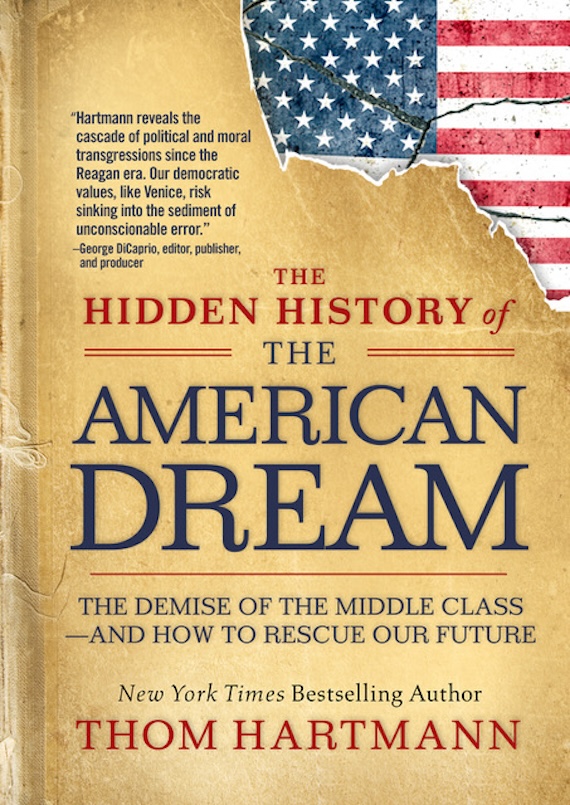
The American Dream isn’t Dead; but it’s on Life Support
Portland, Or. (Special to Informed Comment; Feature) – In the run-up to the 2024 Presidential election, the concept of the American Dream has become more central than ever to our national discourse. Many Americans simply ask, “What happened to it?” In my new book, The Hidden History of the American Dream: The Demise of the Middle Class and How to Rescue Our Future, I address the systematic erosion of the middle class that has taken place over the past four decades — a decline brought about by deliberate economic policies designed to enrich the wealthy at the expense of working people.
For much of our history, the American Dream was defined by a strong, thriving middle class. The ability to buy a home, raise a family, and retire comfortably was once within reach for the average American. From the time of Alexander Hamilton, who advocated for tariffs and protectionist policies to nurture American manufacturing, to the post-World War II boom, we saw how government action could create conditions for middle-class prosperity.
As I explore in my book, the middle class peaked during the post-war period, when policies like high unionization rates, affordable education, and government investment in infrastructure supported widespread economic mobility. By 1980, two-thirds of Americans were classified as middle class. But that all started to unravel with Ronald Reagan’s election.
Reagan’s presidency marked the beginning of a seismic shift in American economic policy, driven by neoliberal principles that favored deregulation, tax cuts for the rich, and the weakening of labor unions. His administration’s assault on unions, beginning with the firing of air traffic controllers in 1981, sent a clear message to corporate America: workers’ bargaining power would no longer be protected. This was followed by free trade agreements and policies encouraging the outsourcing of millions of good-paying, unionized manufacturing jobs. The consequences have been devastating. Over the last 40 years, we’ve seen the hollowing out of the middle class and an unprecedented concentration of wealth at the top.
This economic shift didn’t just come from Republicans — Democrats like Bill Clinton embraced many of these neoliberal policies as well, mainly through trade agreements like NAFTA. These agreements promised prosperity but led to the decimation of our industrial base and the rise of low-wage service jobs. Today, the wealthiest 1% of Americans hold a disproportionate amount of wealth, while working-class families struggle to make ends meet.
The election of Donald Trump in 2016 brought many of these issues to the forefront. Trump’s populist rhetoric tapped into the deep dissatisfaction many working-class Americans felt after decades of being ignored by both parties. He criticized free trade, imposed tariffs, and promised to return jobs to America. While I acknowledge that Trump’s critique of neoliberalism resonated with many voters, his execution was deeply flawed. His tariffs on Chinese goods were haphazard, and they backfired without a comprehensive plan to rebuild American manufacturing. Instead of restoring the middle class, his policies further enriched corporate interests while forcing the federal government to bail out farmers and other industries hurt by the tariffs.
As I argue in The Hidden History of the American Dream, the real solution lies in returning to the progressive values that once defined the Democratic Party. We need to look back to Franklin D. Roosevelt’s policies and the New Deal, which created the most prosperous middle class in world history. By investing in infrastructure, implementing progressive taxation, and protecting workers’ rights, FDR’s administration built an economy that worked for everyone, not just the wealthy elite.
Today, we find ourselves at a crossroads. We must commit to a comprehensive industrial policy revitalizing American manufacturing to rebuild the American Dream. I advocate for reintroducing tariffs and other protectionist measures, not as punitive measures against foreign nations but as a way to incentivize domestic production. Unlike Trump’s tariffs, which were politically motivated and poorly executed, we need a strategic, long-term approach that ensures economic stability while rebuilding our industrial base.
In addition to tariffs, we need a return to Keynesian economics, where the government actively ensures economic fairness. President Biden has quietly implemented policies, such as the Inflation Reduction Act and efforts to break up monopolies. These are steps in the right direction, but more needs to be done to reverse the damage wrought by neoliberalism over the past four decades.
Healthcare, education, and housing must be treated as public goods, not commodities to be exploited by profit-driven corporations. Our housing market, for example, has been overrun by speculators who treat homes as financial assets rather than places where people live. We need policies that make housing affordable and accessible to all Americans, not just the wealthy few. Similarly, the privatization of education and healthcare has left millions of Americans in debt and without access to essential services. Progressive taxation, along with increased public investment in these areas, can help create a more equitable society where everyone has the opportunity to succeed.
The American Dream isn’t dead—but it’s on life support. To revive it, we must reject neoliberalism’s failed policies and embrace a new economic vision rooted in fairness, opportunity, and shared prosperity. This election season allows us to set the country on a new path, one where the middle class can thrive once again. It’s time to take action and reclaim the American Dream for future generations.
Learn more about the Hidden History Series.

No comments:
Post a Comment
Note: Only a member of this blog may post a comment.